Canadian Forces Base Calgary (Harvey Barracks):
Originally established as Sarcee Camp in 1910 as a militia training camp. The government leased a parcel of land form the Sarcee Indian Reservation near the future site of Currie Barracks for the camp and training area. The 50th battalion of the Canadian Expeditionary Force was raised and trained at Sarcee Camp, which grew enormously during the First World War.
During World War II, Sarcee Camp was used extensively for infantry training, conducted by A16 Canadian Infantry Training Centre, which also utilized neighbouring Currie Barracks.
Sarcee Camp remained open at the end of the war as a militia training camp, but in 1957, it became a permanent force (Regular Force) camp, at which time it was re-named Sarcee Barracks.
In 1958, The Lord Strathcona’s Horse (Royal Canadians), an armoured corps regiment, relocated to Sarcee Barracks from Currie Barracks, remaining until transferring to Germany in 1965. Another armoured corps regiment, the Fort Garry Horse, replaced them the following year, remaining until their conversion to a reserve regiment in 1970.
Sarcee also served as a Regional Medical Equipment Depot from May 1960 until closed during a round of DND budget cuts in 1994.
As a result of the Unification in 1968, Sarcee Barracks and Currie Barracks were merged into one base to become Canadian Forces Base (CFB) Calgary, although the names Sarcee and Currie continued to be used.
Sarcee Barracks was re-named Harvey Barracks in 1981, in honour of wartime commander of No. 13 Militia District, Brigadier F.M.W. Harvey. The same year, the Sarcee Training Area was returned to the Tsuu T’ina First Nation, although the Army continued to lease part of the training area from 1985-1996.
In the mid 1990s, a reorganization and consolidation occurred within the Canadian Military. Several bases were either downsized, merged or closed and as a result, Harvey Barracks closed on 21 June 1997, with Currie Barracks closing the following February. The units occupying Harvey Barracks, 1 CMBG and The Lord Strathcona’s Horse, relocated to CFB Edmonton’s Grieshbach Barracks.
In August 1998, members of the Tsuu T’ina First Nation moved into the vacant PMQs due to the shortage of homes on the reservation. The PMQs area was given the name Black Bear Crossing. All other military buildings were eventually demolished, leaving only the abandoned roadways.
By 2006, a controversy ensued when the band council ordered the homes vacated due to a Health Canada warning of possible asbestos contamination. Most of the residents were relocated, but some residents stayed until they were formally evicted. By 2009, the last of the PMQs were demolished and the last remnants of Harvey Barracks vanished.
The Grey Eagle Casino now occupies the north east corner of the former Harvey Barracks.
Source Material: information supplied by Captain D. Sweeney, Deputy Commanding Officer, Area Support Unit Calgary (1999), information supplied by Carol Stokes, Archivist, The City of Calgary (1999), information supplied by Ken Craig, Volunteer Researcher, Museum of the Regiments, Calgary Alberta (1999), “The Politics of Contested Space: Military Property Development in Calgary” – a thesis paper by P. Whitney Lackenbauer, University of Calgary, Department of History, Faculty of Graduate Studies (1999), DND press release from November 1998, information supplied by Terri Griffin (2002), information supplied by Ian Gray, Calgary resident (2003), information supplied by June Flegg, Historian, Saskatoon Public Library (2000), Calgary Forces Base Studio Centre web site – http://www.cfbstudios.com, Canada Lands Corporation Web site – http://www.clc.ca, information supplied by the Tsuu T’ina Police Service (2004), “The Battle for Black Bear Crossing” Fast Forward Weekly, October 30, 2008, the personal recollections of the author (2004) “Abandoned Military Installations of Canada Volume 4: Western and Northern” by Paul Ozorak & “The Garrison” newspaper from March 1995 and Sept 1999.
- Empty fields where buildings once stood, July 2004. Photo: Bruce Forsyth.
- Empty fields where buildings once stood, July 2004. Photo: Bruce Forsyth.
- Empty fields where buildings once stood, July 2004. Photo: Bruce Forsyth.
- Empty fields where buildings once stood, July 2004. Photo: Bruce Forsyth.
- Sarcee Camp in 1915. Photo Credit: Unknown.
- Map showong the Lincoln Park runways, along with Currie Barracks and Sarcee (Harvey) Barracks, 1963. Supplied by Mount Royal College.
- Map showing Currie Barracks/Lincoln Park and Harvey Barracks.
- Map showing the Sarcee/Harvey Barracks Training Area.
- May 2021. Photo: Google Maps.
- Grey Eagle Casino, May 2021. Photo: Google Maps.
- Grey Eagle Casino, May 2021. Photo: Google Maps.
- Oct 2020. Photo: Google Maps.
- May 2012. Photo: Google Maps.
- May 2012. Photo: Google Maps.
- May 2012. Photo: Google Maps.
- May 2012. Photo: Google Maps.
- May 2012. Photo: Google Maps.
- Road leading to the Former site of the rowhouse PMQS, May 2012. Photo: Google Maps.
- Former site of the rowhouse PMQs, May 2012. Photo: Google Maps.
- Former site of the rowhouse PMQs. Photo: Google Maps.
- Former site of the rowhouse PMQs. Photo: Google Maps.
- Photo: Google Maps.
Canadian Forces Base Edmonton (Griesbach Barracks):
Note: Edmonton Garrison, originally CFB Edmonton, was created by the amalgamation of RCAF Station Namao and Canadian Army’s Griesbach Barracks. The Namao site, now called CFB Edmonton (Steele Barracks), remains open today as the home of the Western Canada’s Army.
Established in 1950 as Griesbach Barracks, the base had its beginnings as an ordnance depot, later becoming the home of the Western Command Headquarters.
No. 14 Service Prison and Detention Barracks opened in 1958 at Griesbach. The prison closed briefly from 1968 until 1975. Also in 1958, the 2nd Battalion, Princess Patricia’s Canadian Light Infantry re-located to Griesbach from Currie Barracks.
As a result of the Unification, RCAF Station Namao was combined with the Army’s Griesbach Barracks to form CFB Edmonton on 1 April 1966, falling under control of Air Transport Command.
The Canadian Airborne Regiment was formed at Griesbach in 1968. Two years later, the Canadian Parachute Training Centre re-located to Griesbach from RCAF Station Rivers. Also in 1970, the 1st Battalion, PPCLI re-located to Griesbach in 1970 from Work Point Barracks
In May 1970, 28 Canadian Forces Supply Depot re-located to Griesbach from CFB Shilo. Two months later, the depot was re-designated the Canadian Forces Parachute Maintenance Depot (CFPMD). The Canadian Airborne Centre was also established at Griesbach. However, the Canadian Airborne Regiment re-located to CFB Petawawa in 1977.
Land Force Western Area Headquarters was formed at Griesbach on 1 September 1991, replacing the former Prairie and Pacific Militia Districts.
In 1995, with the disbandment of the Canadian Airborne Regiment, the three feeder units that once provided soldiers to the Airborne, the PPCLI, the Royal Canadian Regiment and the Royal 22nd Regiments (the VanDoos), each established parachute companies. The PPCLI established a Parachute Company at Griesbach Barracks.
In 1996, 1 PPCLI re-located to CFB Namao from CFB Calgary. The CFPMD re-located along with the Canadian Parachute Centre to 8 Wing Trenton in September 1996.
In 1996, corresponding with the move of 3 PPCLI to Griesbach, this parachute company was designated as A Company, 3 PPCLI. Also around this time, CFB Edmonton was re-named Edmonton Garrison.
By the mid 1990s, the city had grown up around Griesbach and Department of National Defence cutbacks lead to questioning the necessity of maintaining two Army bases in the Edmonton area. CFB Edmonton (Namao), formerly an RCAF base, had been transferred to the Army in 1994.
Ultimately, DND decided to consolidate all military operations at the Namao site, now known as Steele Barracks.
Griesbach Barracks closed in 2000. The site, including the 750 PMQs, were transferred to the Canada Lands Corporation in 2002, who have since transformed the former base into “The Village at Griesbach”, a residential community modeled in a village concept.
On 28 September 2001, the Canadian Forces Service Prison & Detention Barracks at Griesbach Barracks closed, having been replaced by a new facility at the Namao site.
Around 17 buildings, along with all the former PMQs on the north-side of the base, were retained in the immediate years after closure, and incorporated into the new Village at Griesbach community. As the property was redeveloped over the next two decades, most of these buildings were demolished. Only the PMQs and the base gym remain today.
The Royal Canadian Artillery Band remained at Griesbach until September 2004, when they re-located to CFB Edmonton’s Steele Barracks. Land Force Western Area Headquarters also remained, housed in the former high school until 2014, when it too re-located to CFB Edmonton’s Steele Barracks. The high school stood until 2020, when it was demolished.
Although the original MGen Griesbach Public School building has been demolished, the school name lives on at a new school building, which was built beside the old building site.
The Edmonton Police Service opened the William Griesbach Training Centre, a recruit training facility, in the former base gym.
In December 2017, 3rd Canadian Division (formerly LFWA HQ) moved into to a new 8,159 square metre building at Steele Barracks, one that also houses 1 Area Support Group Headquarters, the Joint Task Force West, and 3rd Canadian Division Support Group.
The Dianne and Irving Kipnes Centre for Veterans opened 9 November 2005 on a five-acre site just off Castledowns Road and 153rd Avenue, on the northwest corner of the former Canadian Forces Base Griesbach.
The urban renewal underway on the former Canadian Forces Base Griesbach is part of a larger story being written as the Canadian military sells its surplus bases across the country. So far, a dozen such 1940s to 1960s-era surplus bases have been involved in an effort to convert them into well-planned subdivisions and entirely new communities. Its just one of the many advantages of the so-called peace dividend that flowed from the end of the cold war.
In September 2015, a monument commemorating the Royal Canadian Air Force was dedicated at Griesbach. The 10 metre sculpture representing a “star burst” formation, an aerobatic maneuver performed at military air shows, was constructed along with plaques describing Edmonton’s Air Force history, which dates back almost 100 years.
In November 2021, the ATCO Veterans Village opened just to the east of the Griesbach property, at 152A Avenue NW and 94A Street. The project, an initiative by the Homes for Heroes Foundation, provides housing for homeless veterans, along with support services to help them get their lives back on track.
The Veterans Village features 20 housing units, 18 standard units and two accessible units, all less than 300 square feet in size. The homes are arranged in an inward facing barracks-style format to facilitate peer support and a sense of community.
This is the second Veterans Village project, with the first one located in Calgary. The Homes for Heroes Foundation will be opening at third Veterans Village in Kingston in 2022, and has plans for another in Winnipeg.
Source Material: information supplied by Jenelle Turpin, Communications Officer – Council Services, City of Edmonton (1999), information supplied by Charles Denis, Manager Customer Services, Canadian Forces Housing Authority (2004), the CFB Edmonton web site – www.cfbedmonton.hstone.com, DND press releases from February 1994 and November 1998, 440 Squadron history web site – http://www.440sqn.com/frames.htm., “The Garrison” newspaper from March 1995, 1 Air Movements Squadron web site – http://www.mts.net/~rburke1/About%20Us.htm, Canadian Forces Parachute Maintenance Depot web site – http://www.8wing.trenton.dnd.ca/cfpmd/pmdhist.htm, the personal recollections of the author (2004), Real Estate Weekly web site – www.rewedmonton.ca/content_view2?CONTENT_ID=1205 & pamphlet printed by Studio High Techniques of Toronto (1998), “New Headquarters Building for Land Force Western Area”, Canadian Forces web site – http://www.forces.gc.ca/en/news/article.page?doc=minister-nicholson-announces-opening-of-new-headquarters-at-3rd-canadian-division-support-base-3-cdsb-edmonton/hgq87xx8, “Yeg is Home” web site – http://yegishome.ca/news/2004/04/01/new-life-on-the-old-griesbach-barracks, the Village at Griesbach web site – www.villageatgriesbach.com, information provided by Marvin Neumann, Director of Real Estate, Canada Lands Company (2015), “Royal Canadian Air Force monument unveiled in west Edmonton neighbourhood of Griesbach”, https://edmontonjournal.com/news/local-news/new-headquarters-building-for-3rd-canadian-division-was-a-long-time-coming, Edmonton Sun, 20 September 2015, First 20 tenants expected to move into Edmonton’s ACTO Veterans Village | Edmonton Journal, Affordable housing for veterans opens in north Edmonton | CTV News, and the personal recollections of the author (2004) .
- July 2004. Photo: Bruce Forsyth.
- July 2004. Photo: Bruce Forsyth.
- July 2004. Photo: Bruce Forsyth.
- July 2004. Photo: Bruce Forsyth.
- Base Gym, July 2004. Photo: Bruce Forsyth
- Empty fields being re-developed, July 2004. Photo: Bruce Forsyth.
- Empty fields being re-developed, July 2004. Photo: Bruce Forsyth.
- Firehall, July 2004. Photo: Bruce Forsyth.
- Former MGen Griesbach Public School, July 2004. Photo: Bruce Forsyth.
- New homes among converted PMQs, July 2004. Photo: Bruce Forsyth.
- PMQ, July 2004. Photo: Bruce Forsyth.
- PMQ, July 2004. Photo: Bruce Forsyth.
- Former high school, July 2004. Photo: Bruce Forsyth.
- Former high school, July 2004. Photo: Bruce Forsyth.
- Main entrance to the former base, July 2004. Photo: Bruce Forsyth.
- Barracks and parade square, July 2004. Photo: Bruce Forsyth.
- July 2004. Photo: Bruce Forsyth.
- Barracks, July 2004. Photo: Bruce Forsyth.
- Griesbach Barracks,1964. Historical photo.
- Map of Griebach Barracks.
- Former Base Gym, now used as a training centre for Edmonton Police. Photo: Google Maps.
- Former high school, 2009. Photo: Google Maps.
- Former high school site, 2019. Photo: Google Maps.
- PMQs, 2019. Photo: Google Maps.
- PMQs, 2019. Photo: Google Maps.
- PMQs, 2019. Photo: Google Maps.
- PMQs and the Starburst Monument, 2019. Photo: Google Maps.
Canadian Forces Base Penhold:
Originally established 11 miles southeast of Red Deer, Alberta in 1940 as a RCAF Manning Depot.The Royal Air Force took over the property and formed No. 36 Service Flying Training School on 28 September 1941 as part of the British Commonwealth Air Training Plan. Relief Landing Fields were constructed near Innisifail & Blackfalds.
The station consisted of 7 hangars and 31 other buildings including barracks, service buildings, administrative buildings and six hard surfaced runways.
The station was returned to the RCAF closed on 3 November 1944, along with both relief landing fields.
No. 2 Technical Signals Unit, an instrument repair unit, stood-up at the station the following day, remaining unit it was disbanded in September 1945. The station was taken over by the Department of Transport and many of the buildings were demolished or moved off site. Surplus Lancaster bombers were stored in the hangars to await disposal.
The post-war growth of the RCAF resulted in many WWII stations being re-activated, along with RCAF Detachment Innisfail. The station re-opened in late 1951 as RCAF Station Penhold and became home to No. 4 Flying Training School, a NATO Flying Training School. Several new buildings were constructed, including 243 private married quarters, collectively called Mynarski Park, in memory of Andrew Mynarski, VC, the Second World War air gunner who had lost his life trying to rescue his crewmate in a burning Lancaster.
In the early 1960s, additional married quarters were built in Red Deer in a complex known as Vista Village.
The first NATO trainees arrived from Calgary in May 1953, consisting of 22 RCAF trainees, 10 Royal Air Force, 6 French Air Force, 7 Italians and 5 Royal Netherlands Air Force.
The base school was dedicated as Andersons of Craigmyle School in memory of three Red Deer brothers who died in active service with the RCAF, also during the Second World War. A curling rink was built in 1958, a new and larger control tower in 1961 and a new outdoor swimming pool in 1964.
The NATO flying training program ended in the spring of 1959, but air training with the Harvards continued until 1965 primarily for the RCAF but also for the Royal Canadian Navy and pilots from around the world.
By the late 1950s, the threat of a nuclear war had become so great that the Canadian government decided to construct a secret underground bunker to house the major elements of the government in the event of an emergency. Most Provincial Governments followed suit by building their own bunkers.
The Alberta Government chose RCAF Station Penhold for the site of their bunker. A 77,000 square foot bunker, opened in 1964, was secretly constructed just outside the station along Township Road 372 near Highway 2A. It was staffed by the Penhold Signal Troop, of the Royal Canadian Corps of Signals, who were re-designated as 743 Communication Squadron in 1966. The bunker also housed the Provincial Warning Centre. .
All Government bunkers had a remote communications bunker, located some distance away. This second bunker, usually a single story structure, was staffed exclusively by communications personnel. Penhold’s remote communications bunker (17,000 square feet) was constructed several miles south of the station, on the west side of Range Road 282, north of Township Road 362.
43 Radar Squadron opened a Pinetree Line long-range radar station in February 1964, at a site 14 miles east of RCAF Station Penhold, who provided support to the facility. The squadron had actually opened 2 years earlier and operated out of a hangar at Penhold until the new site opened. Most radar personnel lived at the newly constructed Vista Village PMQ area in Red Deer until the mid 1970s.
In May 1965, flying operations ceased at RCAF Station Penhold and Air Defence Command assumed control of the Station. Penhold’s airfield was taken over by the city of Red Deer in 1965 and operated as the Red Deer Regional Airport, remaining so today. Some of the buildings were also taken over by the RCMP around this time.
In the summer of 1966, Regional Air Cadet Glider Training School opened at Penhold. Flying training was conducted at both Penhold and the former RCAF Detachment Innisfail. The name was later changed to the Penhold Cadet Summer Training Centre
As a result of the Unification, the Station was re-named CFB Penhold in 1966.
By 1973, the CF Junior Leadership School and the FPS-27 Radar School had opened at the base. The schools remained at the base until disbanded on 23 June 1986.
In the early 1980s, the Air Cadet School began making use again of the former RCAF Detachment Netook as an alternate airfield to the Gliding School at Innisfail. By 1986, the Gliding School moved permanently to Netook.
In 1985, DND announced that the Pinetree Line would be shut down as a part of the North American Air Defence Modernization Plan. Radar equipment at many Canadian Forces Stations was replaced with a new automated system. As a result of this and overall reductions in Canada’s Air Force, 43 Radar Squadron disbanded on 1 August 1986 and the radar site was closed.
CFB Penhold was downsized to a Detachment of CFB Edmonton in 1990.
In June 1994, the Air Force Junior Leadership School re-located to CFB Borden and was re-named the Air Command Professional Development Training Centre.
In the mid 1990s, a reorganization and consolidation occurred within the Canadian Military. Several bases were either downsized, merged or closed and as a result, Detachment Penhold closed in 1995. The former base is now the community of Harvard Park.
The communications facility was automated and the personnel responsible for running it were transferred to CFB Edmonton. The bunker was closed in 1993 and sold to a private developer in 1995, only to be bought back by the Federal Government and demolished in June 2001 after it was humored that a chapter of the Hells Angels was an expressing interest in acquiring it.
The airfield is now the Red Deer Regional Airport. Most of the original buildings remain in use, including all six hangars, the combined mess, several barracks the firehall, the transportation building and the PMQ homes. The former Penhold School however, now sits vacant.
Remaining behind was the Penhold Cadet Summer Training Centre. With a permanent staff of 114 members, the centre carried on the tradition of training airmen and women at Penhold. The former base headquarters building was used as the HQ for the cadet school. Other buildings were used as classrooms, an infirmary, a warehouse, a giant hangar for indoor sports, and roughly 90 acres of maintained grounds with space to conduct outdoor survival training.
On 15 August 2014, the Penhold Air Cadet Summer Training Centre closed when the Harvard Park Business Centre decided not to re-new the lease, ending 48 years of Air Cadet training and the last remnants of the RCAF at Penhold.
The end of summer graduation parade served as the official send-off for the training centre. Lieutenant- Colonel Allen Gregory Dengis, the Commanding Officer of the Air Cadet Summer Training Camp, delivered his final farewell to the cadets; “Today marks the departure for all of you. I want you to take the friendships, camaraderie and the lessons learned and keep them with you for the rest of your lives.” He named them the “The generation of future leaders of Canada” and thanked them “for being a part of the history of the Cadet Training Program.“
It is noteworthy that last RCAF Harvard to be flown in an operational mission flew at the Penhold base. It was later given to the Red Deer Flying Club for restoration and maintenance and is currently mounted at the entrance to the Red Deer Regional Airport.
Nothing remains at either the radar site, nor the remote communications bunker site, except for the roads leading to them.
The former RCAF Detachment Innisfail was sold and is now operates as the Innisfail Aerodrome.
Nothing remains of RCAF Detachment Blackfalds. The barracks, garage/hangar with control tower and the turf runways are long gone.
Source Material: DND press releases from May 1989 & February 1994, the Air Cadets Glider Training web site – http://www.mts.net/~rgspra/hist.html, “Bunkers, Bunkers Everywhere” by Paul Ozorak, information supplied by Janet Mawson, local resident of Penhold, Alberta (2001), Sea, Army & Air Cadets web page – http://www.cadets.dnd.ca/intro_e.asp, information provided by the Innisfail Flying Club (2004), information provided by, Judy Carleton, President of the Blackfalds Historical Society (2005), the personal recollections of the author (2004), the Pinetree Line web site – www.pinetreeline.org, “Sentinel” Magazine from April 1968, “Abandoned Military Installations of Canada Volume 4: Western and Northern” by Paul Ozorak and “Penhold Air Cadet Summer Training Ends at Harvard Park, 22 August 2014 – Harvard Park Web site: http://harvardpark.ca.
- Map of the Penhold station, July 2004. Photo: Bruce Forsyth.
- Combined Mess, July 2004. Photo: Bruce Forsyth.
- Combined Mess, July 2004. Photo: Bruce Forsyth.
- Base HQ, July 2004. Photo: Bruce Forsyth.
- Hangar, July 2004. Photo: Bruce Forsyth.
- Suppy building, July 2004. Photo: Bruce Forsyth.
- Firehall, July 2004. Photo: Bruce Forsyth.
- Gunnery backstop, July 2004. Photo: Bruce Forsyth.
- Barracks, July 2004. Photo: Bruce Forsyth.
- Hangar, now covered with steel siding, July 2004. Photo: Bruce Forsyth.
- Barracks, July 2004. Photo: Bruce Forsyth.
- Barracks, July 2004. Photo: Bruce Forsyth.
- Barracks, July 2004. Photo: Bruce Forsyth.
- Recreation Centre, July 2004. Photo: Bruce Forsyth.
- PMQs, July 2004. Photo: Bruce Forsyth.
- Harvards on the ramp. DND photo.
- Harvard Monument. Photo: Google Maps.
- Communications Bunker demolition, 2001. Photo: John (Trapper) Nelson.
- Communications Bunker. Photo: Unknown.
- Former location of the bunker, on the road into the base, September 2015. Photo: Google Maps.
Opened in 1941 as the No.1 Relief Landing Field for No. 36 SFTS at Penhold. The aerodrome closed in 1944, along with No. 36 SFTS and it was later sold
In 1960, the Innisfail Flying Club was established at the airfield.
Military flying training returned to the former RCAF Detachment Innisfail when a Regional Air Cadet Gliding School was established at RCAF Station Penhold in the summer of 1966. Flying training was conducted at both Penhold and Innisfail.
In the early 1980s, the Air Cadet Gliding School began making use of the former RCAF Detachment Netook as an alternate airfield to the Gliding School at Innisfail. By 1986, the Gliding School moved permanently to Netook.
The Innisfail aerodrome remains today and is still used by the Innisfail Flying Club, the Central Alberta Gliding and Soaring Club and Alberta Skydive Central.
All the original runways remain, but only runway 34/16 is still in use. An old water cistern also remains, but none of the RCAF buildings. A new club house/terminal building was officially opened on 10 June 1984.
Source Material: information provided by the Innisfail Flying Club (2004), “Abandoned Military Installations of Canada Volume 4: Western and Northern” by Paul Ozorak & the personal recollections of the author (2004).
- Corner of runway 22/04 looking back to runway runway 16/24, August 2014. Photo: Courtesy of Paul Loerke.
- Crumbling runway 22/04, August 2014. Photo: Courtesy of Paul Loerke.
- The sole remaining active runway, 16/24, August 2014. Photo: Courtesy of Paul Loerke.
- A new hangar, August 2014. Photo: Courtesy of Paul Loerke.
- Looking back from the airfield towards where the hangars once stood, August 2014. Photo: Courtesy of Paul Loerke.
- Air photo of the Innisfail Aerodrome, 2000s. Photo: Google Maps.
Royal Canadian Air Force Station Edmonton:
Opened on 5 July 1940 at the Blatchford Field Airport as No. 2 Air Observer School (2 AOS), part of the British Commonwealth Air Training Plan, with World War I flying ace Capt W.R. “Wop” May installed as the civilian manager of the station.
By November 1940, No. 16 Elementary Flying Training School also opened at the aerodrome, remaining until it closed in 1942.
After the closure of No. 2 AOS on 14 July 1944, the station was re-named RCAF Station Edmonton and become the home to Northwest Air Command Headquarters. The station closed in May 1945, but this would be short-lived as it re-opened in October 1946.
Units posted to RCAF Station Edmonton at this time were the Northwest Air Command Composite Flight, 435 Transport Squadron, 418 Tactical Bomber Squadron (Auxiliary), 453 Transport Squadron, the RCAF Winter Experimental Establishment, No. 10 Construction & Maintenance Unit, No. 2 Trade & Advancement Board and RCAF Det Grand Prairie. Later a B-29 Bomber Detachment of the United States Army Air Force (USAAF) and a Survival Training School would occupy space at RCAF Station Edmonton.
1 Air Movements Squadron formed on 1 October 1947 at the station. The Squadron was re-designated 1 Air Movements Unit on 1 April 1951 and assigned to Air Transport Command.
As RCAF Station Edmonton grew in the post-war years, so did the surrounding civilian community. It became apparent that flying activities were becoming hazardous at Blatchford Field when a USAAF transport aircraft crashed into a row of homes shortly after take-off. As a result, the RCAF decided to vacate Blatchford Field and concentrate its activities at the nearby RCAF Station Namao.
RCAF Station Edmonton closed 1 October 1955 and the station’s units re-located to RCAF Station Namao. The aerodrome reverted to a civilian airport, the Blatchford Field Airport. 418 “City of Edmonton” Squadron remained at the airport until 1957 when it too departed for Namao.
The airport, now known as the Edmonton City Centre Airport, became the home to small charters, private and corporate aircraft, training, military, industrial and medevac flights. Most commercial passenger traffic moved to the Edmonton International Airport in the mid-1990s.
Two of the BCATP-era hangars remain at the airport, designated Provincial Heritage Resource in 2000. One of the hangars is the only remaining double width / double depth BCATP hangar left in Canada, is occupied by 180 Royal Canadian Army Cadet Corps, 504 Royal Canadian Air Cadet Squadron & the Alberta Aviation Museum, who work to preserve the memory of the BCATP and the RCAF in Edmonton.
In 2009, Edmonton city council decided on a phased closure of the airport to allow a massive development of housing and commercial real estate starting in 2014. Runway 16/34 was closed to air traffic in August 2010.
In 2012, the Edmonton Flying Club launched a won a court battle that allowed the club to seek an injunction against the Edmonton Airports Authority to evict it from the airport, where it’s been located since 1927. The Edmonton Flying Club had a lease with the city good until 2028, but this was all apparently in vain.
The airport officially ceased operations by 30 November 2013 after 84 years of operations. A Cessna 172 was the last aircraft to leave the airfield. Plans for a pair of RCAF CF-18 fighter jets were scheduled to make a touch-and-go landing as a ceremonial last takeoff, but the plans were scrapped due to bad weather.
The museum and some non-aviation institutions will remain. Some land will be transferred to the Northern Alberta Institute of Technology and the rest will be converted to a primarily residential development.
In 2017, it was announced that Hangar #11 would be demolished as part of the re-development of the airport property, despite being on the Top 10 List of Endangered Historic Places in Canada. Despite those plans, Hangar #11 remained standing for almost another seven years, until a fire destroyed it on 22 April 2024, three days after a similar era hangar at 9 Wing Goose Bay was also destroyed in a fire. At around 80,000 square feet, and constructed of wood, which was typical of that era, Hangar #11 was one of the last of its type.
Source Material: information supplied by Jenelle Turpin, Communications Officer – Council Services, City of Edmonton, the “Wings Over Alberta” web site – http://collections.ic.gc.ca/flyboys/homefront/bcatp_sites.htm (1999), Grandville Island Publishing web site – http://www.granvilleislandpublishing.com/profile/sportscarracing/contents.shtm, the personal recollections of the author (2004), History of Canadian Airports by T. M. McGrath, Fate Of Edmonton Muni May Go To Vote – Canadian Aviator Magazine – www.canadianaviatormagazine.com, Edmonton Journal, 12 September 2013 – http://blogs.edmontonjournal.com/2013/09/12/close-final-city-centre-airport-runway-nov-30-report-recommends, www.cbc.ca/news/canada/calgary/alberta-historic-places-endangered-1.4153875, Two Historic Hangars Destroyed By Fire – Canadian Aviator Magazine & the CFB Edmonton web site – www.cfbedmonton.hstone.com.
- Map showing the layout of the Edmonton City Centre Airport, July 2004. Photo: Bruce Forsyth.
- Edmonton City Centre Airport. Photo credit: Unknown.
- Hangar #14 with a BOMARC missile mounted out front, July 2004. Photo: Bruce Forsyth.
- Historical plaque for the BOMARC Missile our front of Hangar #14, July 2004. Photo: Bruce Forsyth.
- Historial plaque for Hangar #14, July 2004. Photo: Bruce Forsyth.
- Historical photo of one of the hangars.
- Historical plaque for Hangar #14. Photo: Bruce Forsyth.
- Hangar, July 2004. Photo: Bruce Forsyth.
- Hangar #11 along 109 Street NW, July 2004. Photo: Bruce Forsyth.
- Hangar #11 along 109 Street NW, July 2004. Photo: Bruce Forsyth.
- General Aviation Centre, on the former site of Hangar #9, July 2004. Photo: Bruce Forsyth.
- Historical plaque on the General Aviation Centre building, July 2004. Photo: Bruce Forsyth.
- Ansons in the hangar. Historical photo.
- Hangar 11, which is slated for demolition, 2017. Photo: National Trust for Canada.
- Former hangar line along Airport Road NW, September 2016. Photo: Google Maps.
- Former hangar line along Airport Road NW, September 2016. Photo: Google Maps.
- Former hangar line along Airport Road NW, September 2016. Photo: Google Maps.
- 418 Tactical Bomber Squadron (Auxiliary), RCAF Station Edmonton. Photo: Courtesy of Sue Browning.
- The Control Tower at the Edmonton Municipal Airport during WWII. Historical photo.
- Pilot trainees, August 1943. Photo: Courtesy of Wendy Fleming.
- Pilot trainees, August 1943. Photo: Courtesy of Wendy Fleming.
Royal Canadian Air Force Station Lincoln Park:
Originally established on the southern section of Currie Barracks in 1935 by the RCAF, where an unpaved landing strip had been built for their use. By 1939, No. 1 (Fighter) Squadron had moved to Currie Barracks from RCAF Station Sea Island, and No. 3 (Bomber) Squadron from RCAF Station Ottawa (Rockcliffe). The airmen were forced to share the only barrack block with the Lord Strathcona’s Horse, which created problems as the Strathconas awoke to the sound of a bugler every morning at 0500 hours.
On 28 October 1940, a portion of Currie Barracks became No. 3 Service Flying Training School, part of the British Commonwealth Air Training Plan. Relief Landing Fields were constructed near Shapard and Gladys.
No. 3 SFTS closed on 28 September 1945 and the hangars, the airfield and everything south of it was sectioned off and became No. 10 Repair Depot (with a Detachment in Moose Jaw). In 1947, the station then became No. 25 Air Material Base Calgary, but was later re-named Royal Canadian Air Force Station Lincoln Park.
In 1953, Permanent Married Quarters were built for the Airforce personnel, who prior to that all lived in rented or purchased housing with in the City. The single personnel lived in barracks on the base.
Both RCAF Detachments Gladys and Shepard were abandoned. From 1958-1970, the abandoned runways at RCAF Detachment Shepard were used as a racetrack for sports car and motorcycle racing under the name Calgary International Raceway. An industrial complex now occupies the site of the former aerodrome.
Nothing remains of the Gladys aerodrome.
During this period, Lincoln Park served as construction headquarters, a repair depot and NATO pilot refresher-training centre, who by this time had paved runways on which to land.
A primary tenant at the station was Canadian Pacific Airlines (Repair Division), who were a prime contractor for aircraft overhaul for Western Canada.
129 Acceptance and Ferry Flight Detachment, a detachment of No. 6 Repair Depot at RCAF Station Trenton, and a very busy Detachment with usually about 12 Pilots, and six Flight Engineers accumulating many hours of flying time on aircraft from Chipmunk, T-34 Noresman, to Lancasters and Albatross, and Single and Twin Engine Jet aircraft. Most flights were out of RCAF Station Station Calgary, due to the short runways at Lincoln Park.
403 “City of Calgary”. Squadron was re-formed at Linclon Park as a Fighter Bomber Squadron (Auxiliary) in 1948, remaining until it disbanded in 1964. NATO pilot training continued until 1958, after which the airfield was used only as an emergency landing strip.
In the early to mid 1960s, a reorganization and consolidation occurred within the Canadian Military. Several Army, Navy and RCAF bases were either downsized, merged or closed. As a result, RCAF Station Lincoln Park closed in 1964.
The buildings north of the airfield and the Lincoln Park PMQs became part of Currie Barracks. The reminder of the property was sold to the city of Calgary.
Mount Royal University now occupies the part of the property where the airfield was once located, as it has done since 1972, when it was known as Mount Royal College.
On 28 October 2000, the 60th anniversary of the establishment of No. 3 Service Flying Training School, University held a plaque dedication ceremony to honour the men and women who served at the war-time school.
Very little remains of the former RCAF Station Lincoln Park today.
Four of the six original hangars on the north-side of the former airfield, which became part of Currie Barracks, have already been demolished and the remaining two are slated for demolition in 2014.
The six maintenance hangars south of the former airfield, once used as a part of the Repair Depot, were occupied for many years by the ATCO Industrial Complex. These hangars were demolished in 2011.
All that remains of the airfield is the taxi-way beside where the north-side hangars used to stand. Some of the rowhouse PMQs were moved onto one of the former runways at the north end of the property sometime after the airfield’s closure and remain there today, extensively renovated.
The Lincoln Park PMQ area has been re-developed into the “Garrison Green” residential community, modeled on an old “village style”. Some of the former PMQ homes remain, extensively renovated, along with new homes built by the developer. The developer established a park named “Peacekeeper Park”, which includes a memorial dedicated to Canadian Peacekeepers who distinguished themselves and to those who died in the service of their country.
One notable veteran of No. 3 SFTS was William Roy Irwin (1898-1969), a WWI Royal Flying Corps officer and winner of the Distinguished Service Order and Distinguished Flying Cross and Bar. Irwin volunteered for service, once again, with the RCAF, on 9 July 1940. Originally posted to No. 11 SFTS in Yorkton, Saskatchewan, he assumed command of No. 3 on 14 May 1943.
No. 3 SFTS was repeatedly awarded the Air Minister’s Efficiency Pennant under his direction and on 1 January 1944, Irwin was made a Member of the British Empire. He retired from service as a Group Captain in July 1945.
Source Material: information supplied by Captain D. Sweeney, Deputy Commanding Officer, Area Support Unit Calgary (1998), information supplied by Sherry Eastholm, Manager, Sidney (B.C.) Museum (1999), information supplied by June Flegg, Historian, Saskatoon Public Library (2000), History of the 400 Series Squadrons – http://www.airforce.dnd.ca/airforce/eng/history_400s/rcafsqns.htm, Wings Over Alberty web site – http://collections.ic.gc.ca/flyboys/homefront/bcatp_sites.htm, information supplied by Hunter Wight, Executive Director, Public Affairs and Development, Mount Royal College (2001), information supplied by Deb Bramson, Mount Royal College (2001), the “Wings Over Alberta” web site – http://collections.ic.gc.ca/flyboys/homefront/bcatp_sites.htm, Grandville Island Publishing web site – http://www.granvilleislandpublishing.com/profile/sportscarracing/contents.shtm, the personal recollections of the author (2004), the Legion Magazine July-August 2015 & information supplied by Carol Stokes, Archivist, The City of Calgary (1999).
- No. 3 SFTS memorial plaque, 2016. Photo: Theresa Remtulla, Mount Royal University.
- Program for the dedication of the No. 3 SFTS Memorial. Supplied by Mount Royal College.
- Main entrance to Mount Royal College (now University) in the middle of what was once the airfield, July 2004. Photo: Bruce Forsyth.
- Former Lincoln Park aircraft hangar line, now part of Currie Barracks, July 2004. Photo: Bruce Forsyth
- Parking lot where one of the runways once ran, July 2004. Photo: Bruce Forsyth.
- Lincoln Park maintenance hangar at the south end of the former airfield, July 2004. Photo: Bruce Forsyth.
- Lincoln Park PMQs, now being redeveloped into a new neighbourhood, July 2004. Photo: Bruce Forsyth.
- Lincoln Park PMQs, now being redeveloped into a new neighbourhood, July 2004. Photo: Bruce Forsyth.
- “Peacekeeper Park”, which includes a memorial dedicated to Canadian Peacekeepers who distinguished themselves and to those who died in the service of their country, July 2004. Photo: Bruce Forsyth.
- The old and the new. Lincoln Park PMQs, now being redeveloped into a new neighbourhood, July 2004. Photo: Bruce Forsyth.
- Lincoln Park rowhouse PMQs, July 2004. Photo: Bruce Forsyth.
- No. 3 SFTS on the left and No. 10 Repair Depot on the right, with the shared runways in between. Unknown date. Photo Credit: Unknown.
- Source Material: “Abandoned Military Installations in Canada Vol II: Quebec” by Paul Ozorak. No. 44 Canadian Army (Basic) Training Centre/Canadian Officer Cadet and Basic Training Centre:
- Station sign, 1950s. Photo Credit: Unknown.
- Map showong the Lincoln Park runways, along with Currie Barracks and Sarcee (Harvey) Barracks, 1963. Supplied by Mount Royal College.
- Lincoln Park runway diagram. Supplied by Mount Royal College.
- Map showing Currie Barracks/Lincoln Park and Harvey Barracks.
- Pilot trainees at Lincoln Park during WWII. Supplied by Mount Royal College.
- Opening of No. 3 SFTS. Supplied by Mount Royal College.
- Photo Supplied by Mount Royal College.
- 418 Squadron,1944. Photo: Courtesy of Sue Browning, in memory of her father-in-law, F/L James C. Browning RCAF, 418 Squadron (front row, 3rd from the left).
- Map showing the Separd Detachment, 1963. Supplied by Mount Royal College.
- Airplane in front of the hangar at the Shepard Detachment during WWII. Photo: National Archives.
42 Radar Squadron Cold Lake:
Established south of Cold Lake on 1 August 1954 as the Cold Lake Aircraft Control & Warning Squadron (AC&W), home of 42 Radar Squadron Cold Lake.
The Squadron was technically not part of the Pinetree Line, but instead it was used to provide radar control of CF-100 aircraft and as a radio transmission centre. The squadron was renamed simply 42 Radar Squadron in October 1962 and was equipped with the Semi-Automated Ground Environment (SAGE) system as part of the 28th NORAD Region.
As a result of Department of National Defence (DND) budget reductions, the site occupied by 42 Radar Squadron closed in 1992.
42 Radar Squadron re-located to 4 Wing Cold Lake and the squadron’s radar equipment was moved to the Primrose Lake Air Weapons Range. The former station sat abandoned and neglected until 1998, when the Cold Lake Air Force Museum opened.
Today, all of the station’s five buildings (with the catwalk that joined them), plus the guardhouse and pumphouse remain. The former operations building contains displays profiling the Air Force, RCAF Station/CFB Cold Lake and 42 Radar Squadron, including a full-size Hight Finder Radar unit.
The other buildings feature The Oil & Gas Interpretive Centre, Alberta Heritage Museum and the Aboriginal Museum. None of the three radar towers remain today.
Source material: 42 Radar Squadron Cold Lake web site – http://www.4wing.coldlake.dnd.ca/42.html, personal recollections of the author (2004), Cold Lake Air Force Museum – www.coldlakeairforcemuseum.com/main & information supplied by Captain Leah Wilson, Wing Public Affairs Officer, 4 Wing Cold Lake (1999).
- Main gate with operations building in the background, July 2004. Photo: Bruce Forsyth.
- Operations building, July 2004. Photo: Bruce Forsyth.
- Operations building, July 2004. Photo: Bruce Forsyth.
- Telecom building (now Aboriginal Museum) and the Operations building #2, July 2004. Photo: Bruce Forsyth.
- Operations building to the left. Guard house and access road are also visible, July 2004. Photo: Bruce Forsyth.
- Operations building as seen from the main access road approaching the station, July 2004. Photo: Bruce Forsyth.
- Cold Lake Air Force Museum Height Finder Radar Dish inside the former Operations building, August 2008. Photo: SlavicHistorian.
- Operations centre of 42 Radar Squadron, 1967. Photo: Sentinel Magazine.
Royal Canadian Air Force Detachment Airdrie:
Opened north of Calgary in 1940 as the No. 1 Relief landing Field for No. 3 SFTS in Calgary. The Detachment featured the standard triangle pattern runway, along with several buildings including administration and barracks buildings and two large wooden hangars. Student pilots at No. 37 SFTS would spend the last three weeks of their air training course with the Advanced Training Unit at RCAF Detachment Airdrie, where bombing training was conducted.
RCAF Detachment Airdrie closed in 1945.
Student pilots and crop-dusters continued to use the crumbling runways into the 1950s.
In 1954, the abandoned runways were used as a racetrack for sports car and motorcycle racing. In 1957, the RCAF buildings were converted into commercial facilities.
Today the former detachment operates as the Airdrie Airport and industrial complex. The Airdrie Country Club of the Air operated at the airport from the early 1970s until the mid 1980s, when the club disbanded. In the spring of 2005, the club was resurrected and continues to promote general aviation in the Calgary area.
A significant portion of the former Detachment remains today. A number of the maintenance sheds remain, some in use, some not. One of the former barracks is used as the office for Airdrie Mini Self Storage and the remaining hangar is occupied by the Alberta Pallet Company, a wood products manufacturing company. A neighbouring farmer purchased the bombing control tower, which is still standing today.
The original runways remain but are abandoned, with only one of the three is still intact, along with the taxi-way. The other two are broken up and only the outlines can be seen. A new runway was built in 2002 down the middle of the original triangle airfield.
The Airdrie Regional Airshow is held at the airport every 2 years.
Source Material: information supplied by Captain D. Sweeney, Deputy Commanding Officer, Area Support Unit Calgary (1998), “Wings For Victory – The Story of the British Commonwealth Air Training Plan in Canada”, by Spencer Dunmore, Airdrie Flying Club web site – http://www.airdrieflyingclub.ca/story02.htm & the personal recollections of the author (2004)
- Hangar, July 2004. Photo: Bruce Forsyth
- Taxiway with aeroplanes parked off to the side and hangar in the background, July 2004. Photo: Bruce Forsyth.
- Abandoned section of the original runways, July 2004. Photo: Bruce Forsyth.
- Admin / Barracks building? Photo: Bruce Forsyth
- Admin / Barracks building? Photo: Bruce Forsyth
- Entrance to the detachment, July 2004. Photo: Bruce Forsyth.
- Aerial overview of Airdrie, 2013. Photo: Google Maps.
Royal Canadian Air Force Station Claresholm:
Opened west of Claresholm on 9 June 1941 under the British Commonwealth Air Training Plan as No. 15 Service Flying Training School, with Relief Landings Fields at Woodhouse & Pultney. No. 2 Flight Instructor School also operated at the Aerodrome from April-September 1942, when it re-located to Vulcan. No. 15 SFTS closed on 30 May 1945 and the station, although not abandoned, was left with only a small caretaker staff.
RCAF Detachments Woodhouse & Pultney were abandoned.
The post-war growth of the RCAF resulted in many WWII stations being re-activated. RCAF Station Claresholm re-opened in 1951 as a NATO pilot training centre run by No. 3 Flying Training School. The school was so busy that airfields at former RCAF stations at Fort MacLeod and Lethbridge.
As busy as the school was, the school would be short-lived. Claresholm closed again in 1958, this time for good. No. 3 FTS re-located to RCAF Station Gimli.
From 1958-1961, the abandoned runways were used as a racetrack for sports car and motorcycle racing.
The former station is now the Claresholm Industrial Airport. All that remains are some of the station’s former buildings, including the fire hall, maintenance garages and four post-war PMQ houses.
As well, 6 of the original 7 hangars remain:
Hanger #1: owned by Environmental Rescue Equipment, a fire fighting company that are contracted to the Alberta Government.
Hanger #2: owned by Rick Holdings and is currently for sale.
Hanger #3: owned by Grant Lobban. The hangar burned down on 20 December 2014 and all that remains is the concrete pad and apron.
Hanger #4: owned by Ptarmigan Real Estate Ltd. It is currently being restored. – 5 year project.
Hanger #5: owned by ESIP Holdings Ltd., making concrete panels for the construction industry
Hanger #6: owned by Bruce Hagel and leased to a firm that provides material to the construction Industry
Hanger #7: also owned by Bruce Hagel. It is currently vacant.
Trus Joist MacMillan Ltd, an engineered lumber products company, formerly occupied three of the hangars, but have moved elsewhere.
The majority of the property contains only empty fields and abandoned roadways, but some new buildings are popping up on site. Only one runway remains in use; the other five were abandoned years ago.
All that remains of RCAF Detachment Woodhouse is one runway, consisting of severely deteriorated asphalt, and the hangar pad. The other runways were removed for farming. Township Road 122 now cuts across the southern portion of the former triangle runway outline.
A memorial cairn was placed at the airport and a Harvard airplane stands in Centennial Park in Claresholm as a monument to the men and women who served at RCAF Station Claresholm and No. 15 SFTS.
Source Material: Town of Claresholm web site – http://www.town.claresholm.ab.ca/communityprofile.htm#HISTORY, “Canada Flight Supplement 1999”, “Portage La Prairie – Fifty Years of Flying Training: 1940-1990” by Major G.E.I. Greavette, CD, Grandville Island Publishing web site – http://www.granvilleislandpublishing.com/profile/sportscarracing/contents.shtm, information supplied by Brian Waddell, owner of the property once occupied by RCAF Detachment Woodhouse, information provided by Keith Armstrong (2015), the personal recollections of the author (2004) & “The Plan” by James Williams.
- Hangar, July 2004. Photo: Bruce Forsyth.
- Hangar, July 2004. Photo: Bruce Forsyth.
- Hangar Line, July 2004. Photo: Bruce Forsyth.
- Hangar Line, July 2004. Photo: Bruce Forsyth.
- Hangar, July 2004. Photo: Bruce Forsyth.
- Firehall, July 2004. Photo: Bruce Forsyth.
- Remains of building, July 2004. Photo: Bruce Forsyth.
- Monument to the school, July 2004. Photo: Bruce Forsyth.
- Airfield and hangar line, 2013. Photo Credit: RCAF Then And Now Facebook page.
- Airfield and hangar line, 2013. Photo Credit: RCAF Then And Now Facebook page.
- Aerial view, 1958. Photo Credit: RCAF Then And Now Facebook page.
- One of the WW II era hangers undergoing a restoration, 2013. Photo Credit: Unknown.
- Abandoned airfield at RCAF Detachment Woodhouse, 2013. Photo: Google Earth.
- Hangar, 2013. Photo: Kathleen Moors.
- Hangar, 2013. Photo: Kathleen Moors.
- Hangar, 2013. Photo: Kathleen Moors.
- Hangar man door, 2013. Photo: Kathleen Moors.
No. 5 Elementary Flying Training School (High River):
The aerodrome north of High River was originally opened in 1921 by the Canadian Air Force, predecessor to the RCAF, as the High River Air Station. With the creation of the RCAF in 1924, the station was re-named RCAF Station High River. The station was utilized for parachute training and new aircraft testing.
In 1931, RCAF Station High River closed and the aerodrome became a storage depot. Flying activities were limited to the Calgary Aero Club.
The outbreak of World War II lead to the creation of the British Commonwealth Air Training Plan and the establishment of No. 5 EFTS near Lethbridge in 1940, but the school re-located to High River in June 1941. Originally the WWI Bessemer hangars were used until a new hangar was built, along with drill halls, offices and barracks, with new asphalt runways replacing the grass ones. Later in the war, a second one built. A Relief Landing Field was also constructed at Frank’s Lake.
No. 5 EFTS closed on 15 Dec 1944, having graduated 97 classes of airmen, and so did RCAF Detachment Frank’s Lake. The Calgary Flying Club remained at the aerodrome until the late 1940s, when the club re-located to McCall Field in Calgary.
Only one hangar remains, now occupied by Willow Creek Homes, a builder of modular homes as does the old cistern. All that remains of the airfield is the faint outline of the runways.
Nothing remains of the Frank Lake Detachment.
A new airport was established south of High River. The station auditorium was moved into High River and is still used today.
In August 2002, monuments were erected at both the airport and in downtown High River as a tribute to the men and women who served at No. 5 EFTS.
On 1 October 2016, representatives from the High River Legion Branch #71 and Nanton’s Bomber Command Museum of Canada erected a new historical sign dedicated to High River’s Royal Canadian Air Force training station.
A notable veteran of No. 5 EFTS was John Ender “Jock” Palmer (1896-1964). Palmer, a Distinguished Conduct Medal winning WWI Royal Flying Corps veteran, volunteered for service in WWII with the RCAF. Originally employed as a civilian instructor, he was later commissioned as an officer. Spending most of the war at No. 5, he served as an instructor, chief instructor and then Commanding Officer.
In addition to his military and civilian flying career, “Jock” Palmer also founded Lethbridge radio station CJOC-AM in 1926. After several frequency changes, CJOC moved to the FM band, 106.7-FM, under the call letters CJRX-FM, on 19 January 2000. It’s currently branded as 106.7 Rock.
Another Lethbridge radio station, 94.1 CJOC, assumed the call letters after going on the air on 3 July 2007, but has nothing to do with the original CJOC.
Hailed as the “Grandfather of Alberta Aviation,” he was posthumously inducted to the Canadian Aviation Hall of Fame in 1988.
Source Material: information supplied by Regena R. Johnson, Airport Landfill / Road Closure Coordinator (2001), information supplied by Melissa Chamber, local resident of High River (2000), Lancaster Museum web site – http://www.lancastermuseum.ca/highriver.html, the “Wings Over Alberta” web site – http://collections.ic.gc.ca/flyboys/homefront/bcatp_sites.htm, the personal recollections of the author (2004), The Calgary Flying Club – http://www.calgaryflyingclub.com/clubhistory_1940-1945.asp,” High River’s former air force training base memorialized,” High River Times, 7 October 2016, The Legion Magazine July/August 2015, CJRX-FM – Wikipedia & information supplied by Norm Lund, local resident of High River (2001).
Read the book “Life and legends: A History of the Town of High River”, By Lillian Knupp for more information.
- Sole remaining hangar, July 2004. Photo: Bruce Forsyth.
- Road leading into the former station with the hangar in the background, July 2004. Photo: Bruce Forsyth.
- Memorial plaque to No. 5 EFTS and RCAF Station High River, July 2004. Photo: Bruce Forsyth.
- New memorial to High River’s No. 5 EFTS, 1 October 2016. Photo: Paul Krajewsk, High River Times/Postmedia.
- Model of No. 5 at the Bomber Command Museum.
- High River Flying Area.
No. 5 Elementary Flying Training School (Lethbridge):
See entry in “Closed bases that still have a military presence“.
No. 31 Elementary Flying Training School:
Opened 13 kms east of De Winton, Alberta under the British Commonwealth Air Training Plan as a Royal Air Force school on 18 June 1941, with a Relief Landing Fields at Gladys (grass runways) and Shepard (asphalt). The school closed on 25 September 1944, as did RCAF Detachments Gladys and Shepard.
For several years, the abandoned runways were used as a racetrack for sports car and motorcycle racing.
The former school is still listed as a private aerodrome, the South Calgary Airport, although there are no aviation activities currently operating at the site. Two of the runways are severely deteriorated and overgrown with grass, while the third runway and tarmac only partially maintained for use by Alberta Motor Association as a driver training centre for private and commercial drivers.
The Calgary Ultra-light Flying Club used one runway for “touch & go” training for student pilots for a period, but does not currently use the airfield.
Except for the pump-house, no buildings remain in their wartime position on the property. Most of the building foundations do remain however, including both hangar pads.
The former administration building, garage and guardhouse were moved and patched together to create a private residence on the property. As well, the original windsock, flag pole, gunnery backstop and water reservoir also remain.
On 15 June 2016, close to 200 people gathered at the DeWinton airfield to commemorate the 75th anniversary of No. 31 Elementary Flying Training School, during which a bronze plaque commemorating the school was unveiled.
Guests at the ceremony included Flight Lieutenant James Andrews from the Royal Air Force; Dr. Stéphane Gouvrement, a historian and honorary colonel of 419 Tactical Fighter Training Squadron; Susan Cowan, the daughter of one of the school’s commanding officers and Squadron Leader Rae Churchill, a former Second World War instructor at RCAF Station Bowden.
As for RCAF Detachment Shepard, the abandoned runways at were used as as a racetrack for sports car and motorcycle racing, known as the Shepard Raceways, from 1958 – 1970 and then the Calgary International Raceway in the mid 1970s.
The former north-south runway was used as drag race strip until it closed around 1983, when the construction of Deerfoot Trail cut across the old runway. The Alberta Motor Association then used the runway as a driver training facility.
The SE-NW runway and east-west runways were torn up in the early 1970s with construction of Shepard landfill.
Today, nothing remains of the Shepard Detachment. In the early 2000s, the property was redeveloped into an industrial complex. A “Flying J” truck stop now occupies part of the property where the airfield used to be.
Nothing remains of RCAF Detachment Gladys.
Source Material: “Canada Flight Supplement 1999”, David Harris, local resident of De Winton (July 2001) as posted on “As You Were – War Years: News”, the Calgary Ultra-light Flying Club web site – http://www.cufc.ca, July 2001 Edition – http://www.angelfire.com/trek/rcaf/ammq0107.html, information supplied by Jesse Knight, property owner DeWinton Aerodrome (2004), information supplied by Rick Lang, Operations Manager, Alberta Motor Association (2004), information provided by Tim Harris, local resident of De Winton (2004), information provided by Francois Arseneault, History & Heritage Committee, Army Cadet League of Canada (2007), the personal recollections of the author (2004), Grandville Island Publishing web site – http://www.granvilleislandpublishing.com/profile/sportscarracing/contents.shtm and the RCAF web site – http://www.rcaf-arc.forces.gc.ca/en/article-template-standard.page?doc=no-31-elementary-flying-training-school-commemorated/irhk4jm8.
- Aerial View Of Former RCAF Station De Winton, 2012. Photo credit: Unknown.
- Aerial View Of Former RCAF Station De Winton, 2002. Photo credit: Unknown.
- Abandoned runway, July 2004. Photo: Bruce Forsyth.
- Abandoned runway, July 2004. Photo: Bruce Forsyth.
- Abandoned runway 34-16 at the former RCAF Station DeWinton, Alberta, July 2004. Photo: Bruce Forsyth.
- Former administration building, garage and guardhouse moved and patched together to create a private residence, July 2004. Photo: Bruce Forsyth.
- Entrance to the former station where the barracks and administration buildings were once located, July 2004. Photo: Bruce Forsyth.
- Gunnery backstop, July 2004. Photo: Bruce Forsyth.
- The De Winton flight line in the fall of 1941. Photo credit: Unknown.
- Barracks at DeWinton Aerodrome. Photo credit: Unknown.
- Connie Eastcott, Evelyn Patterson, Isabelle Hall and Jean O’Leary, all from Okotoks, smile from the flight line at De Winton during WWII. Photo: Connie Eastcott Bodkin Collection.
- The Dirsten family was just one of many that established itself at De Winton during WWII.. Photo: Dirsten Family Collection.
- Aircraft on the hangar apron at DeWinton. Photo: Tom Wallis collection.
- Photo: Library and Archives Canada.
- Susan Cowan, Squadron Leader Rae Churchill and Flight Lieutenant James Andrews, RAF, unveiled a bronze plaque commemorating No. 31 EFTS De Winton, June 2016. Photo: Anne Gafiuk.
- Close-up of the memorial plaque. Photo: Anne Gafiuk.
- Veterans, former civilian employees of No. 31 Elementary Flying Training School gathered at DeWinton, June 2016. Photo: Anne Gafiuk.
- The former administration building, garage and guardhouse patched together to create a private residence, June 2016. Photo: Anne Gafiuk.
- The main entrance to the aerodeome, June 2016. Photo: Anne Gafiuk.
No. 32 Elementary Flying Training School:
Opened north-east of Bowden, Alberta under the British Commonwealth Air Training Plan on 12 July 1941. A Relief Landing Field was also constructed at nearby Netook, which featured grass runways. The school closed on 8 September 1944, as did RCAF Detachment Netook.
No. 1 Surplus Holing Unit was established 1 May 1945 at the Bowden Aerodrome to store surplus was equipment awaiting disposal. After the unit shut down, the property was used as a reform school and then became its present day facility, a Federal Prison: Bowden Institution.
Nothing remains from the war-time school today.
Source Material: Netook Air Cadet Gliding School web site – http://www.netook.aircadets.ca/history.php3, the “Wings Over Alberta” web site – http://collections.ic.gc.ca/flyboys/homefront/bcatp_sites.htm & “Wings For Victory – The Story of the British Commonwealth Air Training Plan in Canada”, by Spencer Dunmore & the personal recollections of the author(2004).
- Bowden Institution, a federal penitentiary, now occupies the former station, July 2004. Photo: Bruce Forsyth.
Netook Gliding Centre:
Opened as a Relief Landing Field for No. 32 EFTS at Bowden, where student pilots used turf runways for flying training. RCAF Detachment Netook closed in 1944 along with No. 32 EFTS.
In the early 1980s, the Air Force made a return of sorts to the former RCAF Detachment Netook when the Royal Canadian Air Cadets began using the site as an alternate airfield to the Gliding School at Innisfail.
By 1986, the Gliding School moved permanently to Netook where the Netook Gliding Centre carries on the tradition of training airmen and women of the Royal Canadian Air Cadets. In 1990, the Air Cadet League bought the Netook Airfield, cementing the return of the Air Force to Netook.
Besides the grass airfield, all that remains of the WWII school today is one shed/hangar, currently used as an office and storage building for the air cadets. A new steel sided hanger also sits on the property.
Source Material: Netook Air Cadet Gliding Centre web site – http://www.cadets.net/pra/netookgc, the “Wings Over Alberta” web site – http://collections.ic.gc.ca/flyboys/homefront/bcatp_sites.htm, “Wings For Victory – The Story of the British Commonwealth Air Training Plan in Canada”, by Spencer Dunmore & the personal recollections of the author (2004).
- New hangar, July 2004. Photo: Bruce Forsyth.
- Grass runway, July 2004. Photo: Bruce Forsyth.
- WWII-era shed, July 2004. Photo: Bruce Forsyth.
- Aerial view of the aerodrome, 2000s. Photo Credit: Unknown.
No. 36 Elementary Flying Training School / No. 3 Air Observer School / No. 2 Flight Instructors School:
Opened by the Royal Air Force north of the Village of Pearce on 30 March 1942 as No. 36 Elementary Flying Training School, part of the British Commonwealth Air Training Plan. Like most BCATP stations, the aerodrome has three, 3100 foot hard surfaced runways set in a triangular pattern.
No. 36 EFTS had a brief existence as it closed on 14 August 1942.
No. 3 Air Observer School of Regina, Saskatchewan, opened a Detachment at the aerodrome on 12 September 1942. The school operated at the Pearce aerodrome until 6 June 1943 when both the Pearce and Regina schools closed.
Then No. 2 Flying Instructors School, originally from Vulcan, re-located to Pearce on 3 May 1943. The school closed on 20 January 1945.
A detachment of No. 10 Repair Depot in Calgary was established at the aerodrome, tasked with maintenance and storage of surplus equipment pending disposal. Many WWII bombers met their final fate at the Peace Depot, including 140 or so Lancasters that were sent to Pearce from the storage depot at Scoudouc, New Brunswick, because the drier air was less corrosive on the aircraft.
The Depot closed in 1960.
For several years, the abandoned runways were used as a racetrack for sports car and motorcycle racing.
Today, very little remains of the former air station; only some foundations, the crumbling airfield and the old cistern, now used for manure storage. The former station is now a farm, known as “The Airport Dairy”. A monument was erected at the site, using a chunk of concrete from one of the hangars, as a tribute to the men and women who served at the wartime school.
The Village of Pearce no longer exists either. Gone are the General Store, two grain elevators and Pearce School District School House #1686. A memorial to the old schoolhouse sits on the Pearce Road, just north of the former Village.
Source Material: “Wings For Victory – The Story of the British Commonwealth Air Training Plan in Canada”, by Spencer Dunmore, the “Wings Over Alberta” web site – http://collections.ic.gc.ca/flyboys/homefront/bcatp_sites.htm, Grandville Island Publishing web site – http://www.granvilleislandpublishing.com/profile/sportscarracing/contents.shtm, the personal recollections of the author (2004), The Lancaster Museum web site – http://www.lancastermuseum.ca/bcatpalberta.html &
- Entrance to the former RCAF Station Pearce, now Airport Dairy Farms, July 2004. Photo: Bruce Forsyth.
- Hangar pad, July 2004. Photo: Bruce Forsyth.
- Memorial to RCAF Station Pearce, July 2004. Photo: Bruce Forsyth.
- Close-up of Memorial to RCAF Station Pearce, July 2004. Photo: Bruce Forsyth.
- Aerial view of the former RCAF Station Pearce, September 2016. Photo: John Wiley.
- Aerial view, 1942. Photo: Library and Archives Canada.
No. 7 Service Flying Training School:
Opened near the west end of Fort MacLeod under the British Commonwealth Air Training Plan on 9 December 1940, with Relief Landing Fields at Granum and Standoff, but the Pearce Aerodrome was initially used instead of the latter.
The School closed on 17 November 1944, as did the RCAF Detachments Granum and Standoff.
After the war, the station briefly became No. 1 Repair Equipment and Maintenance Unit until it re-located to Lethbridge. No. 101 Reserve Equipment Maintenance Satellite, under the control of RCAF Station Lincoln Park, stood-up, tasked with maintenance and storage of surplus equipment pending disposal.
No. 101 REMS operated until 31 March 1961, when it closed and the RCAF left Fort MacLeod.
For several years, the abandoned runways were used as a racetrack for sports car and motorcycle racing.
Today, the aerodrome is the Fort Macleod airport. One can still see the abandoned original triangle-pattern airfield, but it is rapidly crumbling. A new 3000 foot runway was build across the top of the triangle.
Many of the World War II-era buildings remain including four hangars, an administration building, one of the barracks (currently a private residence), the drill hall and the old water cistern. Two of the hangars are occupied by Albicanlis Lumber and the former HQ building is now a recreation hall, used by 2309 Royal Canadian Army Cadet Corps.
Falcan Industries and an auto scrap yard also occupy part of the property, as does a new home development, “Airfield Properties”, that sits in the centre of the former airfield.
A monument was erected in Memorial Park in Fort MacLeod as a tribute to the men and women who served at the wartime school.
The abandoned airfield also remains at RCAF Detachment Granum, but the property is now used for farming. Nothing remains of RCAF Detachment Standoff, which had turf runways.
Source Material: “Wings For Victory – The Story of the British Commonwealth Air Training Plan in Canada”, by Spencer Dunmore, the “Wings Over Alberta” web site – http://collections.ic.gc.ca/flyboys/homefront/bcatp_sites.htm, Grandville Island Publishing web site – http://www.granvilleislandpublishing.com/profile/sportscarracing/contents.shtm, the personal recollections of the author (2004), “Abandoned Military Installations of Canada Volume 4: Western and Northern” by Paul Ozorak & “Canada Flight Supplement 1999.
- Hangar, July 2004. Photo: Bruce Forsyth.
- Hangar line, July 2004. Photo: Bruce Forsyth.
- Hangar, July 2004. Photo: Bruce Forsyth.
- Firehall, now a private residence, July 2004. Photo: Bruce Forsyth.
- Barracks, July 2004. Photo: Bruce Forsyth.
- Drill hall, July 2004. Photo: Bruce Forsyth.
- Hangar line as seen from the crumbling taxi-way, July 2004. Photo: Bruce Forsyth.
- Hangar line at RCAF Station Fort McLeod, Alberta, as seen from the crumbling taxi-way, July 2004. Photo: Bruce Forsyth.
- Hangar line as seen from the crumbling taxi-way, July 2004. Photo: Bruce Forsyth.
- Air photo as seen in the 2000s. The current runway runs across the crumbling former triangle airfield. Photo Credit: Unknown.
- Control tower during WWII. Photo Credit: Unknown.
- 2020. Photo: Google Maps.
- 2020. Photo: Google Maps.
- 2020. Photo: Google Maps.
- 2020. Photo: Google Maps.
- 2020. Photo: Google Maps.
- 2020. Photo: Google Maps.
- 2020. Photo: Google Maps.
No. 19 Service Flying Training School & No. 2 Flight Instructor School:
Opened under the British Commonwealth Air Training Plan, aerodrome south-west of Vulcan (located at Section 10, Township 16, Range 25, west of the 4th meridian) was originally the site for two different schools during World War II.
The first was No. 2 Flight Instructor School (2 FIS), which opened on 3 August 1942. All flying training schools had one or two relief landing fields located nearby.
The relief field, usually consisting of either grass or asphalt runways, one hangar, maintenance facilities and barracks for overnight stays, allowed pilot trainees to conduct circuit training on landing and taking-off in their airplanes. Some also served as sub-unit training schools. Vulcan’s Relief Landing Fields constructed near Ensign (asphalt runways) & Champion (turf runways).
A total of 750 students graduated from 2 FIS before it re-located to Pearce, Alberta on 3 May 1943.
The same day, No. 19 Service Flying Training School opened at the aerodrome. By the time the school closed on 29 March 1945, a total of 860 pilots had earned their wings. RCAF Detachments Ensign and Champion also ceased operations.
The station’s last Commanding Officer, B.C. Andrews AFC, said to the final graduating class, “The RCAF has been the backbone of a great air training plan which in the space of a few short years has changed the course of world history. The enemy is well aware that the British Commonwealth Air Training Plan has accomplished a tremendous achievement. The aims and objects to provide personnel to maintain air supremacy in every theatre of war has been accomplished. Every member of this great service can be rightfully proud of their participation.”
No. 103 Reserve Equipment Maintenance Satellite was established at the aerodrome, but later No. 10 Repair Depot stood-up, tasked with maintenance and storage of surplus equipment pending disposal. Many WWII bombers met their final fate at the Vulcan Depot, which finally closed in the late 1950s.
For a period the site operated as the Vulcan Industrial Airport, but sat abandoned for many years. Six of the original seven hangars remain, but only two remained use for storage of heavy equipment and farm machinery. The empty fire station, the gunnery backstop, the cistern, part of the transport building and the abandoned & crumbling airfield also remain. Cattle grazed where most of the buildings once stood.
On 15 July 2000, a reunion of former staff and students was held at the Vulcan Airfield. A commemorative monument, built using a portion of the foundation from the guardhouse, was dedicated on the site as a tribute to the service men and women of No. 19 SFTS and No. 2 FIS.
Some windows and doors from the Vulcan hangars are now being used at the British Commonwealth Air Training Plan Museum in Brandon, Manitoba.
In September 2010, several vintage airplanes landed on the abandoned runways at the former RCAF Station Vulcan for the first time in more than 60 years as part of the Bomber Command Museum of Canada’s weekend-long Salute to the Flight Instructors.
The British Commonwealth’s Air Training Plan’s steering committee sought to turn one out of three Southern Alberta airports into a national historic sites, with Vulcan being one of them.
In 2011, the aerodrome re-opened as the Vulcan/Kirkcaldy Aerodrome, operated by Wheatland Industries. The remaining 6 hangars were restored and the years of debris was cleared from the runways and taxiways.
Vertical Extreme Skydiving currently operates out of the aerodrome. One of the former runways was resurfaced for their use.
In 2015, Vulcan became the main Headquarters for the Southern Alberta Gliding Centre of the Air Cadet Gliding Program.
Some of the original windows and doors from the Vulcan hangars are now being used at the British Commonwealth Air Training Plan Museum in Brandon, Manitoba.
All that remains of RCAF Detachment Ensign today is the entrance road and the hangar pad, now used as part of a farm operation. The outline of the runways was still visible around 2013, but has now been ploughed under.
Nothing remains of RCAF Detachment Champion.
Source material: information supplied by Marge Weber, Town of Vulcan (2002), the personal recollections of the author (2004), “Stay Out Of Those Hangars – Little Boys and Big Bombers” by Elgin Keith Jones CD, The Vulcan Advocate – http://www.vulcanadvocate.com (2003 & 2010), Vulcan Air Base web site – http://vulcanairbase.com/index.htm, Vertical Extreme Skydiving web site – http://verticalextremeskydiving.com/about.htmll, “Abandoned Military Installations of Canada Volume 4: Western and Northern” by Paul Ozorak and the Lancaster Museum web site – www.lancastermuseum.com/lancaster.
- Hangar used for storage, August 2014. Photo: Courtesy of Paul Loerke.
- Interior of hangar used for storage, August 2014. Photo: Courtesy of Paul Loerke.
- Abandoned hangar, August 2014. Photo: Courtesy of Paul Loerke.
- Interior of abandoned hangar, August 2014. Photo: Courtesy of Paul Loerke.
- Harvard after landing on the restored runways, August 2010. Photo: John Sands.
- Air photo, 2009. Photo: John Sands.
- Interior of restored hangar, 2009. Photo: John Sands.
- Restored hangar, 2009. Photo: John Sands.
- Air photo prior to the re-activation of the airport. Phot Credit: Unknown.
- Hangars as seen from the road approaching the former station, July 2004. Photo: Bruce Forsyth.
- Main entrance to the Vulcan Industrial Airport, July 2004. Photo: Bruce Forsyth.
- Hangars as seen from the crumbling runways, July 2004. Photo: Bruce Forsyth.
- Crumbling runway, July 2004. Photo: Bruce Forsyth.
- Hangars as seen from the crumbling runways, July 2004. Photo: Bruce Forsyth.
- Monument to the former station, July 2004. Photo: Bruce Forsyth.
- Monument to the former station, July 2004. Photo: Bruce Forsyth.
- Interior of hangar, July 2004. Photo: Bruce Forsyth.
- Hangar line, July 2004. Photo: Bruce Forsyth.
- Hangar, July 2004. Photo: Bruce Forsyth.
- Garage, July 2004. Photo: Bruce Forsyth.
- Gunnery backstop, July 2004. Photo: Bruce Forsyth.
- Gunnery backstop, July 2004. Photo: Bruce Forsyth.
- Alternate entrance with the monument centre left, July 2004. Photo: Bruce Forsyth.
- Back of the firehall, July 2004. Photo: Bruce Forsyth.
Royal Canadian Air Force Detachment Ensign:
Opened in 1942 as a Relief Landing Field for the BCATP school at Vulcan. The Detachment was abandoned after the War.
All that remains of RCAF Detachment Ensign today is the entrance road and the hangar pad, now used as part of a farm operation. The outline of the runways was still visible around 2013, but has now been ploughed under. A white garage on the property might be a former RCAF building
Source material: Places to Fly web site – http://www.copanational.org/PlacesToFly, Google Maps and “Abandoned Military Installations of Canada Volume 4: Western and Northern” by Paul Ozorak.
- RCAF Detachment Ensign seen in 2013. Photo: Google Maps.
- Current view of RCAF Detachment Ensign seen in 2013. Photo: Google Maps.
No. 34 Service Flying Training School:
Originally a dirt airstrip that opened in 1912 outside Medicine Hat, the Royal Air Force assumed control of the aerodrome and opened a flying school on 8 April 1941, part of the British Commonwealth Air Training Plan.
The school also had Relief Landing Fields along the Holsom County Road (paved runways) & in the District of Whitla (grass runways). The RCAF would later take control of the school. Most of the time, the No. 2 relief field didn’t contain too many buildings, fewer than the No. 1 relief field, but Whitla had a barracks, garage & control tower combo, administration building and guard hut.
The school closed on 17 November 1944, as did RCAF Detachments Holsom & Whitla.
No. 102 Reserve Equipment Maintenance Satellite was established initially, but then No. 10 Surplus Equipment Holding Unit stood-up in its place, tasked with maintenance and storage of surplus equipment pending disposal.
The aerodrome was transferred to the Town of Medicine Hat in 1947 and is now the Medicine Hat Municipal Airport. Only two of the original six runways remain in use, one expanded to 5000 ft.
The former fire hall, now used as a meeting hall, also remains, along with one hangar pad and the old German Merchant Navy prisoner of war barracks with their old tar paper covered outer walls and some German graffiti on the inside walls.
A monument was erected at the airport as a tribute to the men and women who served at the wartime school.
Nothing remains of RCAF Detachment Whitla, which was returned to farming.
RCAF Detachment Holsom’s runway was ploughed under for farming as well, but a few chunks of asphalt can still be seen.
Source Material: the City of Medicine Hat web site – http://www.city.medicine-hat.ab.ca/, the “Wings Over Alberta” web site – http://collections.ic.gc.ca/flyboys/homefront/bcatp_sites.htm, “Canada Flight Supplement 1999”, the personal recollections of the author (2004), “Abandoned Military Installations of Canada Volume 4: Western and Northern” by Paul Ozorak & information provided by Cuyler J. Green, Airport Superintendent, Medicine Hat Airport.
- Former firehall, July 2004. Photo: Bruce Forsyth.
- New terminal, as seen past the hangar pad from one of the WWII hangars, July 2004. Photo: Bruce Forsyth.
- New hangar with a mural depicting the Harvard aircraft that once flew from the former station, July 2004. Photo: Bruce Forsyth.
Royal Canadian Air Force Station Calgary:
Originally opened at McCall Field in Calgary, named in honour of World War I Hero Captain Fred McCall, by the Royal Air Force on 22 October 1941. McCall Field had originally been established in 1938 for Trans Canada Airlines (TCA).
Designated as No. 37 Service Flying Training School, it featured the usual amenities found at at BCATP station, including barracks, administration buildings, drill hall, mess halls, stores, lecture halls, medical facilities and hangars, including an arch-style reminiscent of the Royal Flying Corps hangars from World War I.
Relief Landing Fields was also constructed at Airdrie and Inverlake. The school was later taken over by the RCAF. Additionally, a detachment of the United States Army Air Corps occupied space at the airport from 1941-1944 as part of the Alaska Staging Route.
Student pilots at No. 37 SFTS would spend the last three weeks of their air training course with the Advanced Training Unit at RCAF Detachment Airdrie, where bombing training was conducted.
No. 37 SFTS closed on 10 March 1944, as did RCAF Detachments Airdrie and Inverlake, but unlike at most BCATP stations, the RCAF formed a new training school, No. 2 Aircrew Graduates Training School.
The airfield was turned over to the federal Department of Transportation and reverted to a civilian airport in July 1949, making use of some of the RCAF buildings. Not long afterwards, the RCAF leased back some of the buildings for use by various RCAF reserve squadrons, including 403 (Fighter Bomber) Squadron (Auxiliary), 4010 Medial Unit (Auxiliary), 3053 Technical Training Unit (Auxiliary) and 2403 Aircraft Control & Warning Squadron (Auxiliary).
The RCAF side of the airport was designated RCAF Station Calgary and the units were placed under the command of 30 Wing (Auxiliary). In 1957, 403 Squadron was re-designated as an air transport unit, 403 “City of Calgary” (Transport) Squadron (Auxiliary).
A new terminal was built on the civilian side in 1956, replacing the outdated original terminal. The airport became known as the Calgary International Airport in 1966.
RCAF Station Calgary closed in 1964, the victim of massive cutbacks in the RCAF, with 403 Squadron also standing-down. It was re-activated in 1968 at Camp Petawawa as a Tactical Helicopter Squadron.
Only one of the five World War II era hangars remain today, along with the TCA hangar, and the Calgary Aerospace Museum occupies the former drill hall. As well, one of the original arch-style hangars, built in 1938 for Trans Canada Airlines, the predecessor of Air Canada, also remains.
The former RCAF Detachment Airdrie is now the Airdrie Airport. Nothing remains of RCAF Detachment Inverlake today.
Source material: the “Wings Over Alberta” web site – http://collections.ic.gc.ca/flyboys/homefront/bcatp_sites.htm & Canadian Racer web site – www.motorsportcentral.com, information supplied by Bill Watson, Manager of the Calgary Aerospace Museum (2004), “Abandoned Military Installations of Canada Volume 4: Western and Northern” by Paul Ozorak & the personal recollections of the author (2004).
- Arch hangar with the control tower, July 2004. Photo: Bruce Forsyth.
- Hangar housing the Calgary Aero Space Museum, July 2004. Photo: Bruce Forsyth.
- Hangar, July 2004. Photo: Bruce Forsyth.
- BCATP monument, July 2004. Photo: Bruce Forsyth.
- Close-up of BCATP monument, July 2004. Photo: Bruce Forsyth.
- Aerial photo during WWII. Photo Credit: Unknown.
No. 8 Bombing & Gunnery School:
See entry in “Closed bases that still have a military presence“.
Royal Canadian Air Force Detachment Grande Prairie:
Originally opened as a civilian airport in 1928, it was taken over by the Royal Canadian Air Force in 1941, along with units of the U.S. Army Air Corps.
The aerodrome facilities were expanded and the grass strip runway was paved over and two new runways were built.
After WWII, the airport was transferred to the federal Department of Transportation.
On 1 February 1997, control of the airport was transferred to the City of Grande Prairie. Nothing remains from the military days.
Sources: Grande Prairie Airport web site – http://grandeprairieairport.com/airport-information-101/history-2.
- Grande Prairie Airport. Photo: Google Maps.
- Grande Prairie Airport. Photo: Google Maps.
RCAF No. 11 Equipment Depot (No. 11 Supply Depot):
Opened September 1940 in Calgary. Closed November 1951
What is left of No. 11 Supply Depot can be found located between Bonnybrook Road SE, Ogden Road SE, 34 Avenue SE and the railway tracks.
Source Material: http://jfchalifoux.com/bases_stations_calgary_to_cold_lake.htm
- E building North-west corner, August 2014. Photo: Courtesy of Paul Loerke.
- Interior of E building, August 2014. Photo: Courtesy of Paul Loerke.
- South side of W building, August 2014. Photo: Courtesy of Paul Loerke.
- The two remaining buildings, August 2014. Photo: Courtesy of Paul Loerke.
- The two remaining buildings, August 2014. Photo: Courtesy of Paul Loerke.
- Old entrance to this depot, August 2014. Photo: Courtesy of Paul Loerke.
- Air photo showing the depot during WWII and modern day. Photo credit: Unknown.
- Station sign, unknown date. Photo Credit: Unknown.
No. 2 Wireless School:
Opened by the Royal Canadian Air Force on 16 September 1940 under the British Commonwealth Air Training Plan on the grounds of Alberta Provincial Institute of Technology and Art (PITA). No. 2 Wireless School would eventually become one of the biggest wireless training schools in the British Commonwealth, graduating thousands of radio operators.
The school also utilized the RCAF Detachment Shepard for air training.
The school closed on 14 April 1945 and the Provincial Institute of Technology and Art re-opened. Many war veterans attended the school as part of their return to civilian life.
No. 2 Wireless School’s temporary buildings were demolished years ago, but the historic PITA building does remain. The school was re-named the Southern Alberta Institute of Technology in 1965.
Source material: the “Wings Over Alberta” web site – http://collections.ic.gc.ca/flyboys/homefront/bcatp_sites.htm
No. 4 Initial Training School:
Established at the University of Alberta in Edmonton.
- Corbett Hall, University of Alberta. Photo: Courtesy of Wendy Fleming.
- Photo: Courtesy of Wendy Fleming.
- Photo: Courtesy of Wendy Fleming.
- Photo: Courtesy of Wendy Fleming.
- Photo: Courtesy of Wendy Fleming.
- Photo: Courtesy of Wendy Fleming.
- Photo: Courtesy of Wendy Fleming.
No. 130 Non-Permanent Active Militia Training Centre / No. A-20 Royal Canadian Army Service Corps Advanced Training Centre:
See “Closed bases that still have a military presence“.
With the outbreak of World War II, the Non-permanent Active Militia found itself in need of new training camps to train recruits. In 1940, the Camrose Fairgrounds were taken over for use as a Basic Training Centre.
The old grandstand was demolished and over a dozen buildings sprung up. The old Camrose Normal School building, vacated the year before, was taken over as the camp’s Headquarters. The Training Centre officially opened 9 October 1940.
About ten H-Shaped huts were built, as were mess quarters, a medical building and a storehouse.
When the war ended, the fairgrounds and all the camp’s buildings were returned to the city.
Some of the former camp’s H-huts were sold and moved off site as homes. The Royal Canadian Legion Branch 57 bought one for use as its meeting hall at .
Several of the camp’s old buildings do remain on the site, such as the old drill hall, which is now part of the Camrose Community Centre and is used by the local Air Cadet Squadron and Army Cadet Corps.
Source Material: information provided by the Camrose Canadian newspaper (2003), https://3068armycadets.ca, & information supplied by Penny Kinnee, City Clerk’s Office, City of Camrose (2003).
- Former Drill Hall, still at the fromer camp site, now part of the Camrose Community Centre. Photo: Google Maps.
- Hut once located at the former camp site (on 54 Street at the corner of 45 Avenue), now demolished. Photo: Google Maps.
- Hut once located at the former camp site (on 54 Street at the corner of 45 Avenue), now demolished. Photo: Google Maps.
- Former camp building, now the Royal Canadian Legion Branch 57, located on 50 Avenue/Grand Drive. Photo: Google Maps.
- Looking across the former camp site towards the Camore Community Centre. Photo: Google Maps.
- Looking across the former camp site towards the Camore Community Centre. Photo: Google Maps.
No. 133 Canadian Army (Basic) Training Centre:
Opened on 28 January 1942 at the Wetaskiwin Fair Grounds as an Infantry Training Centre. The school closed in August 1945 and the camp was converted to a Sortation unit, tasked with the process of releasing returning members from the RCAF.
The camp itself finally closed in January 1946 when the Sortation Unit relocated to Calgary.
All that remains today is the drill hall, now part of the Wetaskiwin Civic Centre.
Source Material: “Siding 16: The History of Wetaskiwin, 1930 to 1960” by A. Bert Reynolds & the personal recollections of the author (2004).
- Former drill hall, now part of the Wetaskiwin Community Centre. Photo: Google Maps.
- The camp during WWII. Historical photo.
No. 2 Special Wireless Station Grande Prairie:
Opened in 1942 as No. 2 Special Wireless Station. The station was originally supposed to be a part of Canada’s National Signals Intelligence (SIGINT) organization, but instead was operated by Air Force Headquarters.
The station was deemed surplus and closed in 1947.
Source Material: Canada’s National Signals Intelligence (SIGINT) organization web site – www.tscm.com.cse.html & information supplied by Mary Nutting, Archival Assistant, Grande Prairie (2002).
No. 2 Canadian Women’s Army Corps Training Centre:
Opened in 1942 on the grounds of the Vermilion School of Agriculture, which closed for the duration of the war. Lady Eaton of the Eaton’s Department Store, served as the Commanding Officer of the training centre. Every six weeks, 500 young ladies would commence a new training course.
No. 2 CWACTC closed in 1944 and the school returned to its pre-war use.
Today, the former agriculture school is known as Lakeland College. Only the drill hall, now the Auto Mechanic building, and the former Officers’ Barracks, now Alumni Hall, remain today.
Source Material: the personal recollections of Bob Maggs, local resident of Vermillion (2004) & the personal recollections of the author (2004).
- The former drill hall, July 2004. Photo: Bruce Forsyth.
- Former officers’ barracks, July 2004. Photo: Bruce Forsyth.
- Air photo of the campus. Photo Credit: Unknown.


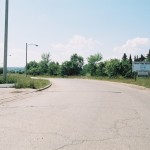
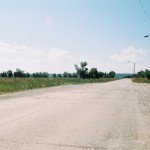

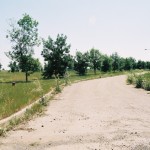
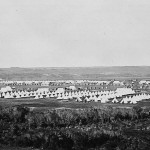

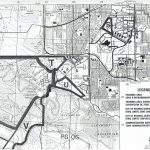



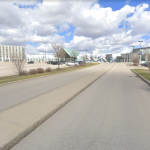
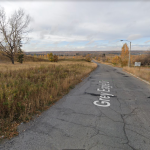







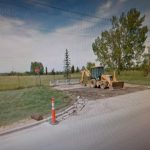
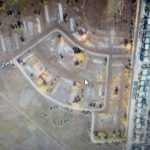
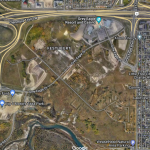


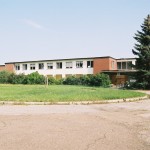
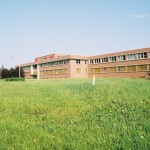


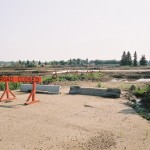
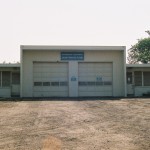

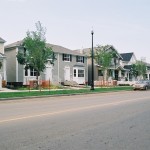

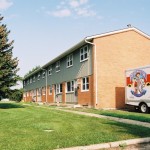
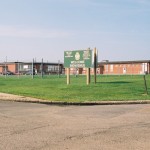
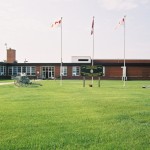
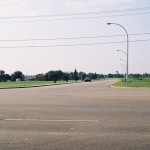
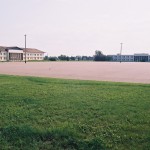
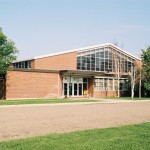
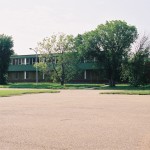







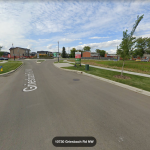

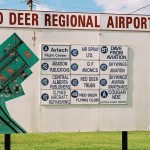

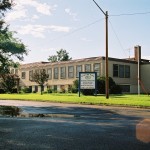

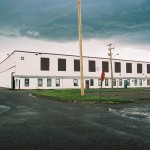

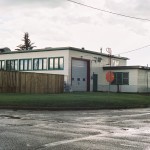

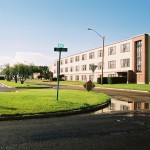

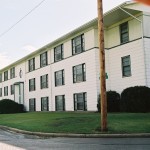
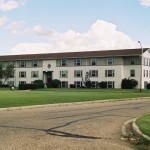


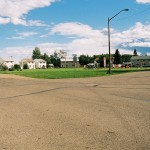
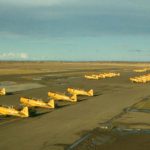
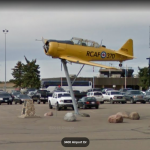



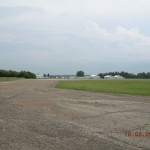


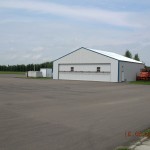

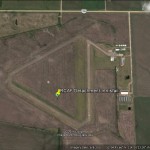


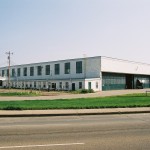


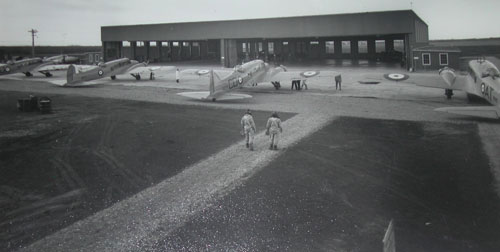
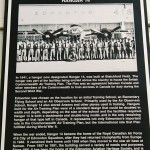
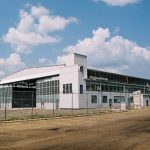









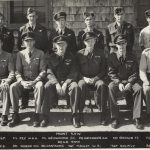
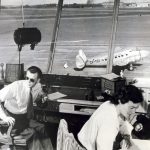

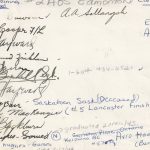


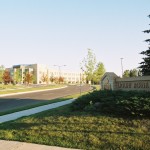

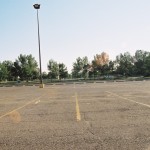


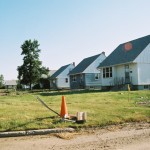
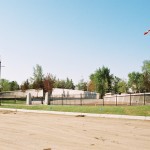
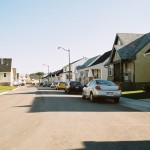
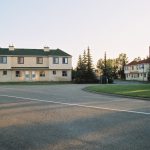
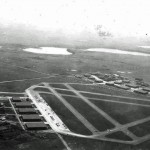


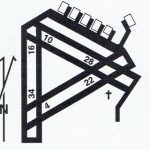


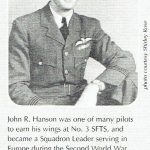


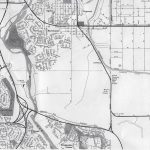

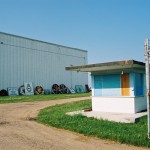
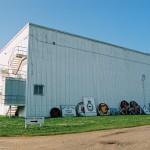





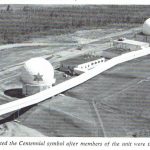
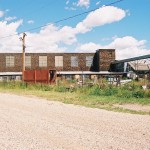


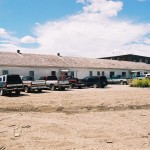



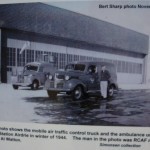



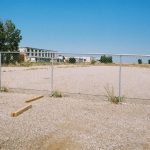



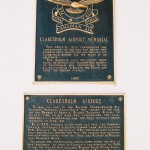

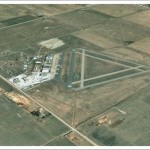

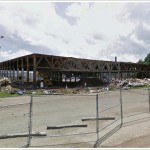
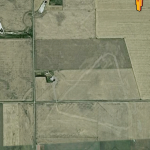
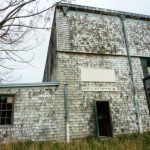




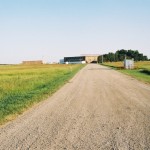


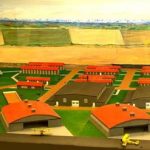
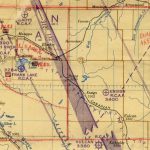

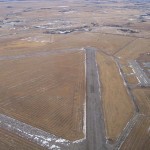





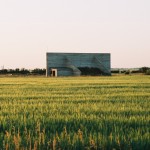

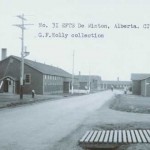
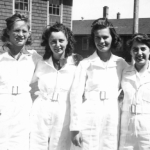





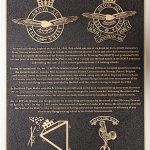

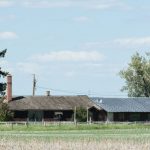

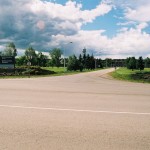

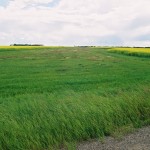


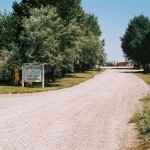








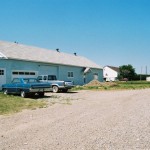




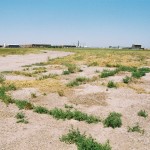



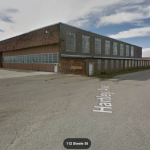

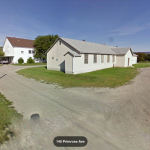
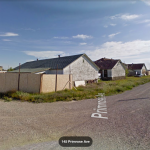
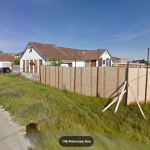
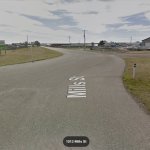



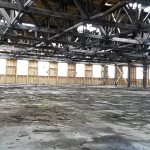
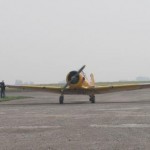
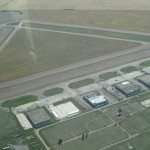




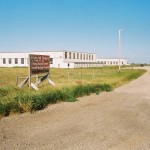

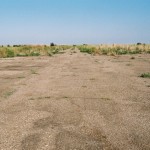
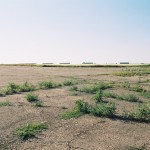
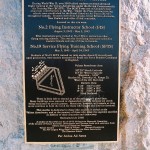

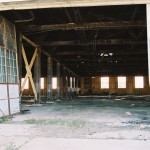
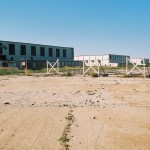
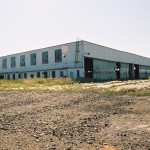


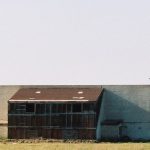




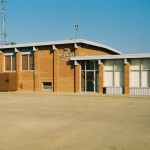


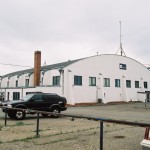
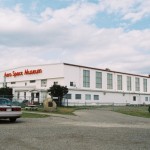
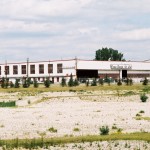

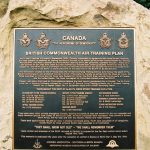





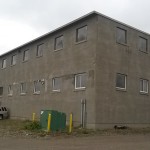
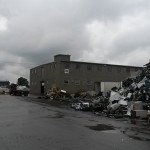
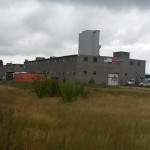

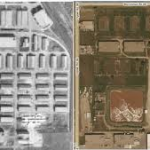




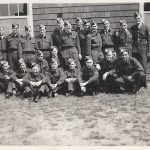


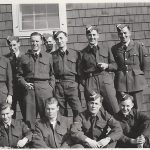


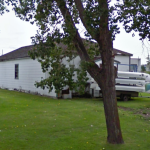

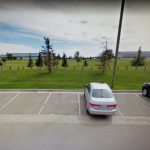







53 pings
Skip to comment form ↓